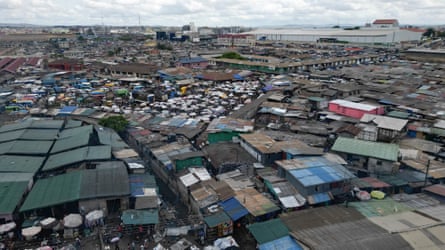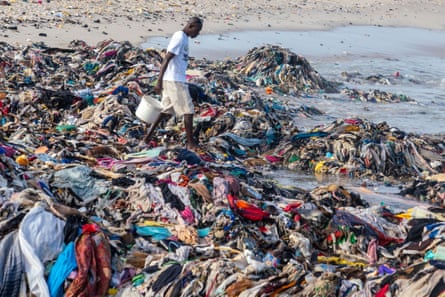A group of secondhand clothes dealers from Ghana have visited Brussels to lobby for Europe-wide legislation to compel the fashion industry to help address the “environmental catastrophe” of dumping vast amounts of textiles in the west African country.
The traders from Kantamanto in Accra, one of the world’s largest secondhand clothing markets, met Alice Bah Kuhnke, an MEP with Sweden’s Green party, environmental organisations and representatives from the European Commission and the European Environment Bureau to argue that proposed extended producer responsibility (EPR) regulation should ensure Ghana receives funds towards managing the 100 tonnes of clothing discarded at the market every day.
EPRs require producers to pay for the waste produced by their products. France is the only European country with an EPR covering the textile sector.
Critics say the policy does little for “end-of-line” countries such as Ghana – because the fee paid by clothing producers is low at just €0.06 (5p) for each item, and the funds raised do not “follow exports” to countries such as Ghana, which are suffering the consequences of over-production and consumption in wealthy countries.
The Kantamanto traders want the draft EPR policy – due to be submitted in June – to increase the fee to a minimum of €0.50 cents for each item, and to guarantee a fair portion of the money goes to the countries where the secondhand clothes end up, including at least 10% towards an environmental fund to clean up previous damage.

Kantamanto was founded in 1960 as a result of colonial mindsets that encouraged Ghanaians to wear western clothes. Today, it covers approximately 7 hectares of land (18 acres), handles about 15m clothing items a weekly, and provides work for around 30,000 people.
Retailers buy and sort through 55kg (121lb) bales of clothing – most of it is either “deadstock” (clothes kept in warehouses and storerooms for years but never worn) or items donated to charities or left in recycling bins. Every week, about 6 million of the higher-quality products are upcycled or sold in the market.
About 40% of textiles arriving in Kantamanto is discarded. The growth in “fast fashion” is pushing that figure up, and bringing a higher volume of lower-quality secondhand clothes. The drop in quality leads to more waste and erodes the traders’ earnings, sending many into debt.
“Kantamanto makes visible the problem that exists in Europe,” said Samuel Oteng, a designer and community engagement manager with the Or Foundation, a US environmental organisation based in Accra that works with Kantamanto and funded the delegation’s visit to Europe.
“But Kantamanto also has the solutions,” he said. “I’ve seen the resilience of Kantamanto, but the support and recognition is not there.”
The traders want new legislation to acknowledge the role of Kantamanto’s workers in recycling the global north’s cast-offs.
“By nearly any other measure, recirculating 6m items of clothing weekly is an astonishing feat. What leaves Kantamanto Market as waste does so largely because there is simply too much clothing, not because people are not working hard to manage it,” according to the Waste Landscape report, published by the Or Foundation in 2022.

Solomon Noi, a member of the Accra Metropolitan Assembly delegation, and the director of waste disposal, stated that the city could not cope with the amount of market waste. Ten legal garbage dumps were shut down in Accra between 2010 and 2020 after they reached capacity.
Approximately 30% of the waste clothing is transported to Adepa, a 50km dump located 30 miles north of Kantamanto. But the other 70% of waste clothing ends up in the drains and ditches. Dye leaches into the water and covers the beaches.
“It is growing in the sea – turtles cannot come to the beach, the coral is dying, the fishers can’t fish. It’s an environmental catastrophe,” said Noi, speaking at the ChangeNOW conference in Paris, which the delegation visited after lobbying in Brussels.
The global north has a duty to assist with logistics and waste management infrastructure, he said.
“We rely on our taxes [to raise money] to manage the waste, but taxes go to education, health,” Noi said. “Little is left to manage textile waste. Why should I pay more taxes just to rid myself of textile waste? [the global north’s] waste? We have had enough.”
Or Foundation also calls on apparel companies to reveal the amount of clothing they produce every year, and commit to reduce that volume by at least 40%.
“None of this matters if we don’t slow down production,” said Liz Ricketts, a co-founder of the organisation. “The issue isn’t organic versus non-organic; there is simply too much clothing.”